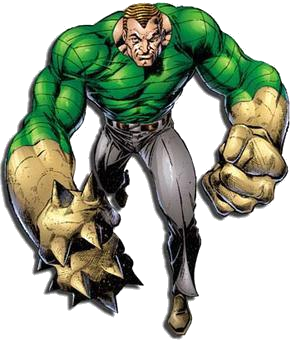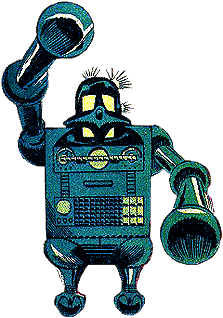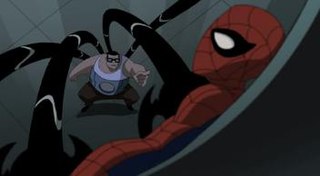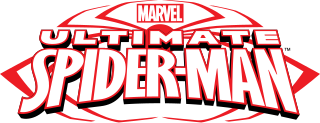
The Amazing Spider-Man is an ongoing American superhero comic book series featuring the Marvel Comics superhero Spider-Man as its title character and main protagonist. Being in the mainstream continuity of the franchise, it was the character's first title, launching seven months after his introduction in the final issue of Amazing Fantasy. The series began publication with a March 1963 cover date and has been published nearly continuously to date over six volumes with only one significant interruption. Issues of the title currently feature an issue number within its sixth volume, as well as a "legacy" number reflecting the issue's overall number across all Amazing Spider-Man volumes. The title reached 900 issues in 2022.

Spider-Man is a superhero appearing in American comic books published by Marvel Comics. Created by writer-editor Stan Lee and artist Steve Ditko, he first appeared in the anthology comic book Amazing Fantasy #15 in the Silver Age of Comic Books. He has been featured in comic books, television shows, films, video games, novels, and plays.

Spider-Man and His Amazing Friends is a 1981–1983 American animated television series produced by Marvel Productions, considered to be a crossover series connected to the 1981 Spider-Man series. The show stars already-established Marvel Comics characters Spider-Man and Iceman, along with an original character, Firestar. As a trio called the Spider-Friends, they fight against various villains of the Marvel Universe.

Spider-Man, also known as Spider-Man: The Animated Series, is an American superhero animated television series based on the Marvel Comics superhero of the same name. The series aired on the Fox Kids Network from November 19, 1994, to January 31, 1998, for a total of five seasons comprising sixty-five episodes, and ran reruns on Toon Disney's Jetix block and on Disney XD. The series was produced by Marvel Films and animated by Tokyo Movie Shinsha.

Doctor Octopus, also known as Doc Ock for short, is a fictional character appearing in American comic books published by Marvel Comics. The character was created by Stan Lee and Steve Ditko and first appeared in The Amazing Spider-Man #3. He is a highly intelligent, myopic, and stocky mad scientist who sports four strong and durable appendages resembling an octopus's tentacles, which extend from the back of his body and can be used for various purposes. After his mechanical harness became permanently fused to his body during a lab accident, he turned to a life of crime, and came into conflict with the superhero Spider-Man. He has endured as one of Spider-Man's most prominent villains, and is regarded as one of his three archenemies, alongside the Green Goblin and Venom. He is the founder and leader of the Sinister Six, the first supervillain team to oppose Spider-Man.

The Sandman is a fictional character appearing in American comic books published by Marvel Comics. A shapeshifter endowed through an accident with the ability to turn himself into sand, he started out as a recurring adversary to the superhero Spider-Man, but has redeemed himself over time, eventually becoming an antihero. The Sandman has also been an enemy of the Fantastic Four and is a founding member of the supervillain teams the Sinister Six and the Frightful Four.

"Spidey Super Stories" is a live-action, recurring skit on the original version of the Children's Television Workshop series The Electric Company.

Spider-Man is a 1981–1982 American animated TV series based on the Marvel Comics character of the same name. It is the second Spider-Man cartoon, following the 1967 series.

Iron Man, also known as Iron Man: The Animated Series, is an American animated television series based on Marvel Comics' superhero, Iron Man. The series aired from 1994 to 1996 in syndication as part of The Marvel Action Hour, which packaged Iron Man with another animated series based on Marvel properties, the Fantastic Four, with one half-hour episode from each series airing back-to-back. The show was backed by a toy line that featured many armor variants.
The Marvel superhero character of Spider-Man has appeared in multiple forms of media besides the comics, including on television numerous times, in both live action and animated television programs.

The Spectacular Spider-Man is an American superhero animated television series produced by Sony Pictures Television based on the Marvel Comics character Spider-Man, and developed by Greg Weisman and Victor Cook. In terms of overall tone and style, the series is based primarily on the Stan Lee, Steve Ditko and John Romita Sr. era of The Amazing Spider-Man, with a similar balance of action, drama and comedy as well as a high school setting. However, it also tends to blend material from all eras of the comic's run up to that point in addition to other sources such as the Ultimate Spider-Man comics by Brian Michael Bendis and Mark Bagley, as well as Sam Raimi's Spider-Man film trilogy.

The Living Brain is the name of two supervillains appearing in American comic books published by Marvel Comics. Created by writer Stan Lee and artist Steve Ditko, the original Living Brain first appears in The Amazing Spider-Man #8 and has made few subsequent appearances since.

The Green Goblin is the alias of several supervillains appearing in American comic books published by Marvel Comics. Created by writer Stan Lee and artist Steve Ditko, the first and best-known incarnation of the Green Goblin is Norman Osborn, who is regarded as one of the superhero Spider-Man's three archenemies, alongside Doctor Octopus and Venom. Originally a manifestation of chemically induced insanity, others would later take on the persona, including Norman's son Harry Osborn. The Green Goblin is depicted as a criminal mastermind who uses an arsenal of Halloween-themed equipment, including grenade-like Pumpkin Bombs, razor-sharp bats, and a flying Goblin Glider, to terrorize New York City.

"Reaction" is the eighth episode of the American animated television series The Spectacular Spider-Man, which is based on the comic book character Spider-Man, created by Stan Lee and Steve Ditko. The episode originally broadcast in the United States on the Kids WB! block for The CW on May 3, 2008.

"Catalysts" is the seventh episode of the animated television series The Spectacular Spider-Man, which is based on the comic book character Spider-Man, created by Stan Lee and Steve Ditko. The episode sees Spider-Man trying to stop the psychotic supervillain Green Goblin from bombing a dinner party filled with high-class New York citizens on the night of his school's big Fall Formal.

Ultimate Spider-Man is an American superhero animated television series broadcast on the cable network Disney XD, based on the Spider-Man comics published by Marvel Comics. The series featured writers such as Brian Michael Bendis, Paul Dini, and Man of Action.

"If This Be My Destiny...!" is a story arc featuring the Marvel Comics superhero Spider-Man. It spans the issues The Amazing Spider-Man #31–33 (1965-1966), and was written by Stan Lee and Steve Ditko, the latter of whom also did the art. The story introduces supporting characters Harry Osborn and Gwen Stacy, Spider-Man's nemesis Doctor Octopus temporarily assuming the Master Planner alias, and Spider-Man being pinned under heavy machinery, which he lifts after gathering enough will power through thoughts of his family.

Otto Gunther Octavius is a fictional character portrayed by Alfred Molina in Spider-Man 2 (2004) and later in the Marvel Cinematic Universe (MCU) film Spider-Man: No Way Home (2021), based on the Marvel Comics character of the same name. Octavius is introduced in Spider-Man 2 as a nuclear physicist and friend and mentor of Peter Parker, whose research into fusion power with his wife Rosie is being sponsored by Oscorp's genetic and scientific research division, headed by Harry Osborn.

Spidey and His Amazing Friends is an animated television series produced by Marvel Studios Animation and Atomic Cartoons that premiered on Disney Junior on August 6, 2021. The show features young versions of the Marvel characters.


















